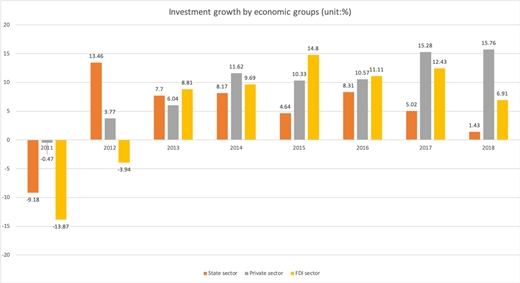Australia supports Economic Reform in Vietnam (Aus4Reform)
- en
- News and Media
- Aus4Reform News
- State investment, FDI no longer driving forces for Vietnam economic growth
31/10/2019
State investment, FDI no longer driving forces for Vietnam economic growth
The private sector has become the main contributor to economic growth for the last three quarters.
State investment, FDI no longer driving forces for Vietnam economic growth
The private sector has become the main contributor to economic growth for the last three quarters.
Impacts from state investment for development and foreign direct investment (FDI) in Vietnam’s economic growth are diminishing, and no longer considered main driving forces, according to Nguyen Dinh Cung, former director of the Hanoi-based Central Institute for Economic Management (CIEM).
 |
| Overview of the workshop |
In the first ten months of 2019, disbursement of public investment funds reached 69.2% of the estimate and was up 5.3% year-on-year, compared to respective 70.3% and 12.1% in the same period last year.
“The progress so far has made it difficult to meet the disbursement target by year-end,” Cung said at a workshop under the program “Australia supports Vietnam’s economic reform” (Aus4Reform), held on October 30 discussing the country’s economic outlook.
 |
| CIEM's projections for Vietnam's economy in the 2019 - 2020 period. |
Meanwhile, 3,094 new foreign-invested projects have been approved with total commitments of US$12.83 billion year to date, up 25.9% in number of projects and down 14.6% in capital year-on-year.
This indicates the growing trend of downsized FDI projects in Vietnam, Cung said, raising the question of the quality of these projects, particularly given the fact that China-related investment capital accounted for nearly 50% of total registered capital. “With small projects, it is possible that investors are trying to reduce investment risks in Vietnam.”
But more importantly, it equally means the chance of transferring modern technologies or R&D activities, the criteria the Vietnamese government is looking for in attracting FDI, is lower, Cung continued.
In parallel with smaller FDI projects, the additional amount of capital injected into existing FDI projects has also fallen 16.4% year-on-year.
Cung, however, noted foreign indirect investment surged 70.5% year-on-year in the January – October period to US$10.81 billion, meaning the same amount of capital was withdrawn from the economy. “It means nothing if this capital is not reinvested into the economy.”
Cung also expressed concern over the fact that Vietnam’s economic growth remains highly dependent on exports. In the first ten months of 2019, Vietnam recorded a trade surplus of US$7 billion with the US continuing to be the country’s largest export market with a turnover of US$49.9, up 26.6% year-on-year, followed by the European Union with US$34.2 billion, down 1.9%, and China with US$32.5 billion, down 2.9%.
“Vietnam puts itself under great risks by having high export turnover with the US, as the latter would not allow this situation to go on for long,” Cung continued.
 |
Meanwhile, 3,094 new foreign-invested projects have been approved with total commitments of US$12.83 billion year to date, up 25.9% in number of projects and down 14.6% in capital year-on-year.
This indicates the growing trend of downsized FDI projects in Vietnam, Cung said, raising the question of the quality of these projects, particularly given the fact that China-related investment capital accounted for nearly 50% of total registered capital. “With small projects, it is possible that investors are trying to reduce investment risks in Vietnam.”
But more importantly, it equally means the chance of transferring modern technologies or R&D activities, the criteria the Vietnamese government is looking for in attracting FDI, is lower, Cung continued.
In parallel with smaller FDI projects, the additional amount of capital injected into existing FDI projects has also fallen 16.4% year-on-year.
Cung, however, noted foreign indirect investment surged 70.5% year-on-year in the January – October period to US$10.81 billion, meaning the same amount of capital was withdrawn from the economy. “It means nothing if this capital is not reinvested into the economy.”
Cung also expressed concern over the fact that Vietnam’s economic growth remains highly dependent on exports. In the first ten months of 2019, Vietnam recorded a trade surplus of US$7 billion with the US continuing to be the country’s largest export market with a turnover of US$49.9, up 26.6% year-on-year, followed by the European Union with US$34.2 billion, down 1.9%, and China with US$32.5 billion, down 2.9%.
“Vietnam puts itself under great risks by having high export turnover with the US, as the latter would not allow this situation to go on for long,” Cung continued.
Source: Hanoitimes.vn

